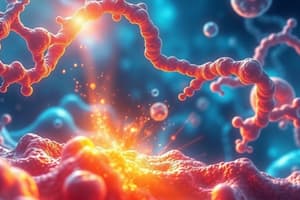Podcast
Questions and Answers
For ATP hydrolysis, the Gibbs free energy change $, \Delta G°$ is positive.
For ATP hydrolysis, the Gibbs free energy change $, \Delta G°$ is positive.
False
An endothermic reaction is defined as one where $, \Delta H°$ is positive.
An endothermic reaction is defined as one where $, \Delta H°$ is positive.
True
The increase in disorder for a process is represented by a negative value of $, \Delta S°$.
The increase in disorder for a process is represented by a negative value of $, \Delta S°$.
False
The unfolding of a protein is spontaneous if the temperature exceeds $, 0 °C$.
The unfolding of a protein is spontaneous if the temperature exceeds $, 0 °C$.
Signup and view all the answers
The equation $, \Delta G = \Delta H - T \Delta S$ can be used to find conditions for spontaneity.
The equation $, \Delta G = \Delta H - T \Delta S$ can be used to find conditions for spontaneity.
Signup and view all the answers
The standard enthalpy change for the reaction ATP → ADP + Pi is slightly positive.
The standard enthalpy change for the reaction ATP → ADP + Pi is slightly positive.
Signup and view all the answers
At 310 K, the calculation for $, \Delta S°$ for ATP hydrolysis gives a value of $34.0 , J , mol^{-1}$.
At 310 K, the calculation for $, \Delta S°$ for ATP hydrolysis gives a value of $34.0 , J , mol^{-1}$.
Signup and view all the answers
The process of protein folding is always spontaneous under physiological conditions.
The process of protein folding is always spontaneous under physiological conditions.
Signup and view all the answers
Study Notes
ATP to ADP + Pi Reaction
- The hydrolysis of ATP to ADP and inorganic phosphate (Pi) has a standard Gibbs free energy change (G°) of -30.5 kJ mol-1
- The standard enthalpy change (H°) for this reaction is -20.1 kJ mol-1
- The standard entropy change (S°) can be calculated using the equation G = H - TS
- S° is 34.0 J mol-1 at 37 °C (310 K)
- The negative enthalpy change indicates that the reaction releases heat, making it energetically favorable.
- The positive entropy change indicates that the reaction increases disorder, which is also favorable.
- The overall negative Gibbs free energy change confirms that the reaction is thermodynamically favorable and spontaneous.
- The equilibrium will lie towards the products (ADP + Pi) because the process is thermodynamically favorable.
Protein Unfolding
- Protein unfolding is the process where a folded protein transitions into a less ordered, unfolded state.
- The unfolding process requires the input of energy (endothermic) as the protein structure needs to be disrupted.
- Unfolding is generally accompanied by an increase in entropy (more disorder) as the folded, compact structure becomes less organized.
- The standard enthalpy change (H°) for protein unfolding is 250.8 kJ mol−1
- The standard entropy change (S°) for protein unfolding is 752 J K-1 mol-1
- Unfolding becomes spontaneous when the Gibbs free energy (G) is negative
- The temperature at which the unfolding process becomes spontaneous (G=0) can be calculated by setting the Gibbs free energy equation to zero and solving for T:
- T = H / S = (250.8 kJ mol-1) / (0.752 kJ K-1 mol-1) = 333.7 K or 60.7 °C
- Above 60.7 °C, the protein will spontaneously unfold due to the dominant influence of the entropy term.
Comments on the Values
- The enthalpy change is associated with the change in bond energies between reactants and products
- A negative enthalpy change (exothermic) indicates energy is released.
- A positive enthalpy change (endothermic) indicates energy is required.
- The entropy change represents the change in randomness or disorder.
- A positive entropy change indicates an increase in disorder.
- A negative entropy change indicates a decrease in disorder.
- The Gibbs free energy change is a measure of the spontaneity or feasibility of a process.
- A negative Gibbs free energy change indicates the process is spontaneous (favorable).
- A positive Gibbs free energy change indicates the process is non-spontaneous (unfavorable).
- Note:* The temperature at which a reaction becomes spontaneous will be higher if the enthalpy change is positive (energy is required) or if the entropy change is negative (there is a decrease in disorder).
Studying That Suits You
Use AI to generate personalized quizzes and flashcards to suit your learning preferences.
Related Documents
Description
This quiz explores the thermodynamics of ATP hydrolysis and the process of protein unfolding. Participants will learn about Gibbs free energy, enthalpy, and entropy changes associated with these biological reactions. Test your understanding of these fundamental biochemical concepts and how they impact energy transfer in cells.




